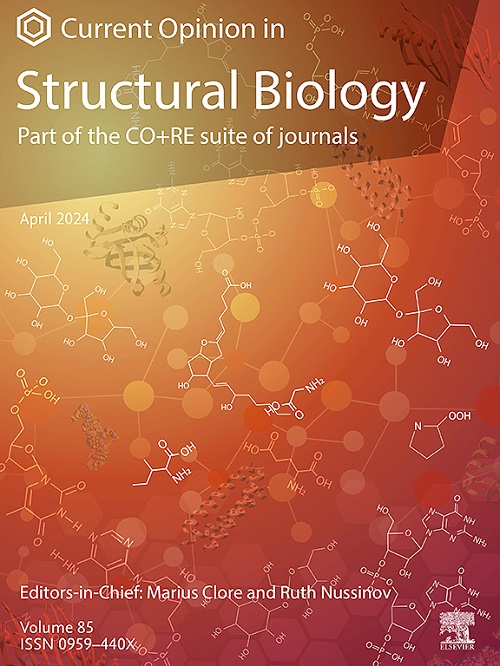利用非天然碱基配对系统增强分子尺技术,探索黄病毒 RNA 的构象动力学。
IF 6.1
2区 生物学
Q1 BIOCHEMISTRY & MOLECULAR BIOLOGY
引用次数: 0
摘要
RNA 固有的灵活性和动态性给使用传统技术(包括 X 射线晶体学、核磁共振(NMR)光谱和冷冻电镜)描述其结构和动态带来了巨大挑战。电子顺磁共振(EPR)光谱法、X 射线散射干涉测量法(XSI)和佛斯特共振能量转移法(FRET)这三种互补的分子尺技术可以测量溶液中纳米范围内的分子内和分子间配对距离分布,它们在探索 RNA 结构和动力学方面越来越受欢迎并得到广泛应用。成功应用此类技术的前提条件是分别用自旋标签、荧光标签或金纳米粒子对 RNA 进行位点特异性标记,但这具有挑战性,尤其是对大型 RNA(一般大于 200 nts)而言。在此,我们简要回顾了这些分子标尺的基本原理、NaM-TPT3 非自然碱基对系统如何赋予它们权力,以及它们在探索大型 RNA 构象动力学方面的应用,尤其是在黄病毒 RNA 基因组方面的应用。本文章由计算机程序翻译,如有差异,请以英文原文为准。
Empowering the molecular ruler techniques with unnatural base pair system to explore conformational dynamics of flaviviral RNAs
RNA's inherent flexibility and dynamics pose great challenges to characterize its structure and dynamics using conventional techniques including X-ray crystallography, nuclear magnetic resonance (NMR) spectroscopy and cryo-electron microscopy. Three complementary molecular ruler techniques, the electron paramagnetic resonance (EPR) spectroscopy, X-ray scattering interferometry (XSI) and Förster resonance energy transfer (FRET) which measure intramolecular and intermolecular pair-wise distance distributions in the nanometer range in a solution, have become increasingly popular and been widely used to explore RNA structure and dynamics. The prerequisites for successful application of such techniques are to achieve site-specific labeling of RNAs with spin labels, fluorescent tags, or gold nanoparticles, respectively, which are however, challenging, especially to large RNAs (generally >200 nts). Here, we briefly review the basics of these molecular rulers, how the NaM-TPT3 unnatural base pair system empower them, and their applications to explore conformational dynamics of large RNAs, especially in the context of flavivirus RNA genome.
求助全文
通过发布文献求助,成功后即可免费获取论文全文。
去求助
来源期刊

Current opinion in structural biology
生物-生化与分子生物学
CiteScore
12.20
自引率
2.90%
发文量
179
审稿时长
6-12 weeks
期刊介绍:
Current Opinion in Structural Biology (COSB) aims to stimulate scientifically grounded, interdisciplinary, multi-scale debate and exchange of ideas. It contains polished, concise and timely reviews and opinions, with particular emphasis on those articles published in the past two years. In addition to describing recent trends, the authors are encouraged to give their subjective opinion of the topics discussed.
In COSB, we help the reader by providing in a systematic manner:
1. The views of experts on current advances in their field in a clear and readable form.
2. Evaluations of the most interesting papers, annotated by experts, from the great wealth of original publications.
[...]
The subject of Structural Biology is divided into twelve themed sections, each of which is reviewed once a year. Each issue contains two sections, and the amount of space devoted to each section is related to its importance.
-Folding and Binding-
Nucleic acids and their protein complexes-
Macromolecular Machines-
Theory and Simulation-
Sequences and Topology-
New constructs and expression of proteins-
Membranes-
Engineering and Design-
Carbohydrate-protein interactions and glycosylation-
Biophysical and molecular biological methods-
Multi-protein assemblies in signalling-
Catalysis and Regulation
 求助内容:
求助内容: 应助结果提醒方式:
应助结果提醒方式:


